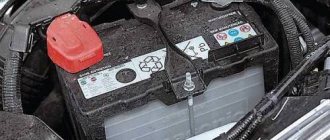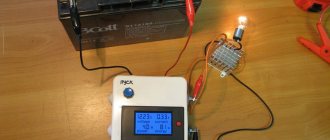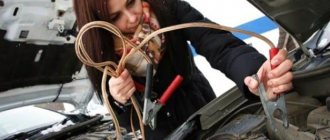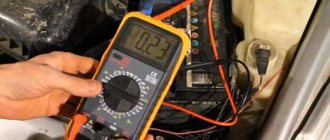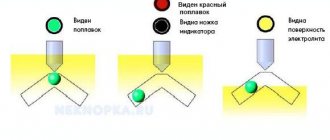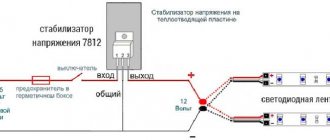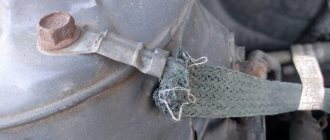Built-in indicator
Most imported batteries have a built-in indicator that can be used to check the charge. For the first time such batteries appeared in Japan. Then European manufacturers began to practice a similar trick.
What is its essence? There is a transparent window on the battery cover (a kind of peephole). If you look at it, you can see that it is colored green. But this doesn't always happen. The green tint in the window will only appear if the battery is fully charged. If the window is transparent or white, it means the battery has lost part of its charge. The worst case is a black window. In this case, the battery has run down and needs to be charged urgently.
For your information, this is one of the easiest ways to check the charge of a car battery without a voltmeter and other devices. After all, all you need to do is open the hood and look through that very window. But it is worth noting that not all batteries have such a peephole (especially when it comes to domestic ones). Therefore, to determine the charge level, you need to know other methods.
Load fork
This is perhaps the most professional way to check the condition of the battery. Typically this method is used at service stations. What is its essence? The device is connected to the battery terminals and provides short circuit current.
That is, the load fork simulates the operation of the starter and shows how many volts the battery drops when the driver tries to start the engine. To date, this is the most accurate scheme for checking the condition of the battery. To read the readings correctly, remember that after loading the battery voltage must be at least 10 Volts. If the battery drops to 9 and below, it means it is already weak. Such a battery will discharge quickly in winter.
What charge should a car battery have?
The primary task of the battery is to provide the starter with the required current at the moment the power plant starts. When the engine is stopped, the battery supplies current to various vehicle systems: headlights, acoustics, lighting. Even during a trip, if the generator does not have enough power, the battery comes to its aid. That is why proper functioning of all vehicle electrical systems is only possible with a fully charged external source.
The norm for a standard 6-cell battery can be considered a value of 12.6-12.9 volts. In other words, the voltage of one fully charged cell should be 2.1-2.15 volts. If a lower voltage is displayed, the battery is discharged.
However, in practice, batteries are operated with an incomplete charge. Below in the table you can see the ratio of the on-board network current (with and without load) to the degree of charge. On the other hand, you cannot use a battery with a voltage of less than 12 volts, as this will sharply reduce the battery life. For this reason, it is necessary to periodically monitor the condition of the battery to prevent a decrease in capacity and charge.
| Electrolyte density, g/cm. cube (+15 degrees Celsius) | Voltage, V (no load) | Voltage, V (with load 100 A) | Battery charge level, % | Electrolyte freezing temperature, gr. Celsius |
| 1.11 | 11.7 | 8.4 | 0 | -7 |
| 1.12 | 11.76 | 8.54 | 6 | -8 |
| 1.13 | 11.82 | 8.68 | 12.56 | -9 |
| 1.14 | 11.88 | 8.84 | 19 | -11 |
| 1.15 | 11.94 | 9 | 25 | -13 |
| 1.16 | 12 | 9.14 | 31 | -14 |
| 1.17 | 12.06 | 9.3 | 37.5 | -16 |
| 1.18 | 12.12 | 9.46 | 44 | -18 |
| 1.19 | 12.18 | 9.6 | 50 | -24 |
| 1.2 | 12.24 | 9.74 | 56 | -27 |
| 1.21 | 12.3 | 9.9 | 62.5 | -32 |
| 1.22 | 12.36 | 10.06 | 69 | -37 |
| 1.23 | 12.42 | 10.2 | 75 | -42 |
| 1.24 | 12.48 | 10.34 | 81 | -46 |
| 1.25 | 12.54 | 10.5 | 87.5 | -50 |
| 1.26 | 12.6 | 10.66 | 94 | -55 |
| 1.27 | 12.66 | 10.8 | 100 | -60 |
We use a multimeter
This is an indispensable device that every motorist should have. Allows you not only to check the battery voltage level, but also the resistance of the sensors, the load of the on-board network in real time and many other important parameters. You can purchase this device for 300-700 rubles, which is 2-3 times cheaper than a load fork. This device is very easy to use.
How to check the charge of a car battery with a multimeter? First you need to assemble it. We perform the following actions:
- We connect two wires with positive and negative polarity to the corresponding connectors.
- There will be probes at the ends of the wires. We apply them to the battery terminals.
- First, set the device to voltage measurement mode and set the rotary switch to 20 Volts.
- We connect the multimeter leads to the battery and look at the result. In this case, the car ignition must be turned off.
Electrolyte
There is another way to check the charge of a car battery with your own hands. It is especially relevant on the eve of winter. As is known, with a drop in temperature, the density of the electrolyte decreases. Accordingly, the charge and performance of the battery decreases. How to check the charge of a car battery? For this we need a hydrometer. Below are detailed instructions:
- So, open the hood and, using a negative screwdriver, unscrew the battery “banks” one by one. There are only 6 of them.
- We immerse our hydrometer inside and wait until it is filled with electrolyte.
- Next, we take the device out and look at the readings.
- After a short time, the float will float to the desired level. There will be several divisions on the scale. A figure of 1.23-1.27 grams per cubic centimeter is considered normal. If the electrolyte density is 1.2 grams, then the battery is about a quarter discharged. A deep discharge is indicated by a reading of 1.1 or less grams per cubic centimeter.
It is also worth checking the electrolyte level itself in each of the “cans”. If it is insufficient, it should be renewed. This can be done with distilled water (coolant is also diluted with it).
Do not ignore insufficient electrolyte level in the battery. This can cause frequent loss of charge and shedding of lead plates. As a result, the battery will become unusable, and during any attempts to recharge, the liquid will boil.
How to check a car battery for short circuit at home
The situation with the inability to start a car after a frosty night is familiar to many car enthusiasts. It is the battery that takes on the main load of starting a cold engine. Even a newly installed battery can suddenly fail its owner.
Constantly driving short distances or faulty electrical equipment can cause the battery to constantly be undercharged. Checking the voltage at the battery terminals with a multimeter before starting the car will show the true charge of the battery. Readings ranging from 11.5 to 11.8V indicate that the battery is completely discharged. There are several reasons for this situation. Current leakage can occur due to headlights not being turned off, a faulty generator, the presence of complex alarm systems, or security cameras. A small amount of current is consumed by the central locking unit and the radio memory. Acceptable leakage current is within the range of 50-80mA. Stationary charging of the battery can correct the situation.
Sufficient charge, but unsuccessful attempts to start the car are a reason to think about another possible cause of the malfunction. In addition to charging, the performance of the battery is affected by the required amount and density of the electrolyte. For maintenance-free batteries, due to lack of access to banks, this parameter is not determined in any way.
Driving short distances causes the battery to be undercharged
With conventional batteries, in the heat of summer, the electrolyte level may decrease due to boiling. Then you need to add distilled water purchased at a pharmacy or auto store. If the level is lost due to spillage, electrolyte is added to the batteries. In winter, when the permissible density decreases, there is a danger of complete freezing of the electrolyte.
To determine the density, the electrolyte is poured into a transparent container, a special float-hydrometer is lowered into it, which allows you to determine the existing readings on a graduated scale. The density can be increased by adding the required amount of acid to the electrolyte.
This work is unsafe and painstaking. It is necessary to carefully monitor the density level of each battery cell. It is advisable to achieve slightly higher densities than recommended by the manufacturer.
Can I charge at home?
If there is no garage, it is possible to recharge the battery in the apartment. But it’s better to do this on the balcony. During this process, the electrolyte releases sulfur dioxide and oxygen chloride, which are harmful to humans. Inhaling it may cause dizziness and nausea. Therefore, we charge in the most remote and well-ventilated area. Also monitor the electrolyte condition.
Do not allow the battery to boil. This reduces its resource. On average, a 60-amp passenger battery charges in 7-8 hours. In this case, the charger must be set to the minimum current strength. Stress loads are harmful to the battery. If the battery takes a long time to charge, or one of the cans boils after half an hour, it means it has become unusable.
What it is
The battery plays an important role in the operation of the car, being one of the main elements of electrical equipment. The battery acts as a current source when the engine is not running. The battery's job is to perform several functions, including:
- supplying current to the starter when starting the car;
- power supply to all electrical devices when the engine is not running;
- power supply of all electrical appliances along with the generator when the engine is running.
On a note! The joint operation of the battery with the generator allows for transient processes that require a large amount of current. In addition, when working together in the vehicle’s electrical network, the current ripple is smoothed out.
The principle of operation of the battery is quite simple. Charged particles in the battery begin to move after being connected to a load. This leads to the formation of current. While charging the battery from a charger or generator, the particles begin to move in the opposite direction. This is due to the fact that the charge voltage exceeds the battery voltage, that is, its nominal value.
Signs of a bad battery
Some signs may indicate that your battery is dead or broken, including:
- The engine started to start very sluggishly (the starter turns poorly). As a rule, this indicates a low battery charge, which is not enough to ignite the fuel mixture, since the spark is quite weak;
- The battery charge does not last for a long time. Most often, motorists encounter this problem in winter, when a fully charged battery is only enough for a few engine starts. A rapid decrease in battery charge is often indicated by insufficient electrolyte levels.
The car does not start well - a sign of a faulty battery
These signs cannot be ignored, since the battery can fail at the most inopportune time, for example, somewhere far outside the city. Therefore, at the first signs of malfunctioning battery operation, diagnostics must be carried out immediately.
Battery categories
All batteries are divided into three types: maintenance-free, low-maintenance and maintenance-free.
Before purchasing, you need to figure out what type of battery is needed:
- Serviceable - fully repairable devices. It allows you to replace the plates and control the level and density of the electrolyte. This is an outdated model. It becomes unpopular precisely because it quickly breaks down if poorly maintained. Most often this happens due to boiling and evaporation of the electrolyte. Such a battery requires constant monitoring.
- Low-maintenance batteries are distinguished by the design of their lids, which allows electrolyte vapor to condense and return to the jar. They rarely have to be serviced, but the need to monitor the electrolyte level remains.
- Maintenance-free - this is a sealed design; they do not need to be serviced; it is not possible to add water or check the density of the electrolyte. But if used correctly, it is reliable and will work for a long time.
You need to buy a battery of the capacity specified in the car’s instructions. It is possible to choose a slightly larger container. This will help the car start more easily in winter conditions.
It is better to purchase batteries in specialized stores. They always check the battery upon purchase. The goods in such stores are certified, and if they are defective, they will be replaced. Nowadays, the most common batteries are low-maintenance ones. They have a long service life and a good ratio between price and quality.
Common Causes
There can be many reasons for a battery to malfunction. Let's look at the most common of them:
- driver inattention. Drivers often leave their car with electrical devices turned on (radio, indicators, light bulbs), which causes the battery to quickly discharge;
- poor device maintenance. If you do not periodically clean the battery terminals, the risk of breakdown increases. This may also reduce the service life;
- long-term use. All car parts have a service life. This also applies to the battery. After the warranty period for the battery expires, various processes may occur in it (sulfation, oxidation, etc.);
- low quality electrical wiring. If poor-quality wiring was installed on the car, then over time it can rot and wear out, which causes a short circuit or discharge of the battery;
- errors when connecting electrical appliances. This may degrade battery performance and shorten battery life;
- poor generator performance. If the generator is faulty, then while the engine is running it will not charge the battery normally. To troubleshoot the problem, it is necessary to carry out diagnostics.
Causes of battery failure
In most cases, battery failures can be prevented. To do this, you need to carry out timely maintenance and repair your car only in high-quality workshops.
The jar has shorted - why is it scary?
As you understand, the battery needs to be used, charged, maintained, etc. correctly. For example, if there is an overcharge, then the lead plates in the structure can simply crumble, in the literal sense of the word, to the bottom of the jar, which will reduce the accumulation of battery energy to a critically minimal level.
But it happens that a piece of lead falls out of the plate, which bridges the plus and minus plates. This results in a short circuit.
It may also be due to lead sediment falling to the bottom, the whole point is that the plates reach the bottom, and if the sediment fills the lower part, then it is the cause of the short circuit.
The battery cannot charge to the required 12 - 13 Volts, and the voltage flounders around 10 - 11V. That is, a closed bank does not work! Such a battery cannot crank the engine starter, and therefore is practically useless in the car; replacement is required.
Methods for checking the battery
You can check the condition of the battery using various methods, including diagnostics using a load plug, multimeter, and charger. Also during the verification process, an external inspection of the battery and electrolyte testing is carried out. Now let's look at each method separately.
Visual inspection
An external inspection is the first thing to do when checking a car battery. At this stage, you can identify mechanical damage to the case, oxidation of the terminals or contamination of the battery surface. Experts recommend carrying out such a check regularly, since the cleanliness of the battery can also affect its functioning. The inspection procedure will not take much of your time, so it can be done every time you lift the hood.
How to test a battery with a multimeter.
Today we’ll talk about how to test a battery with a multimeter. I had a chance to watch some videos on YouTube about this, and some made me want to cry. Interestingly (as luck would have it) they come up in searches more often. But we are frankly grateful to some authors. This could include, for example, the master who cuts videos for the website circuit engineering.ru. The entire process of servicing a car battery is shown very clearly and simply. Nothing to complain about. With the permission of the author, we will glean some information from the video to illustrate our examples.
